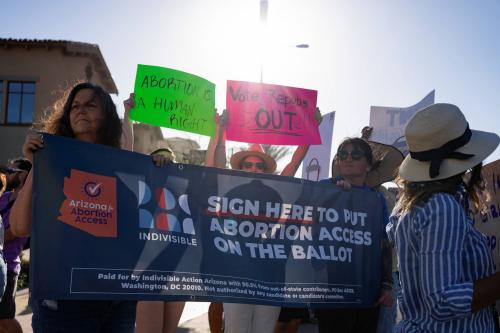When Congresswoman Liz Cheney (R-WY) loses her leadership post in the House of Representatives, as she is likely to do this week, the door to becoming the first female Republican speaker will have closed. But another has opened. She may have started down a path to being the first woman Republican president.
Cheney’s path to the presidency began at the beginning of 2021 when she became one of only 10 Republicans to vote against Trump in the Electoral College vote in the House. Following that she became one of the few Republicans to vote to impeach Trump for his role in the January 6 insurrection at the Capitol. Since then, as Trump himself has spoken out against her and a growing number of Republican members of Congress have called for her to be removed from the number 3 slot in the leadership of their caucus, she has staked out a very clear and very different course. “Finally,” she wrote in the Washington Post, “we Republicans need to stand for genuinely conservative principles, and steer away from the dangerous and anti-democratic Trump cult of personality…. “I am committed to doing that no matter what the short-term consequences might be.”
Notice the words “short-term.”
Cheney is only 54 years old. These days that makes her practically a teenager in a country that has seen two presidents in their seventies, two Senate leaders in their seventies and a House of Representatives leadership team in their eighties. In other words, she’s got time on her side. Here’s what this means.
Political scientists have studied the role of socialization in politics for many decades. What they have found (with, of course, the exceptions and caveats that accompany social science) is that early party identification tends to be pretty stable across a person’s life. Young people who start out voting Democratic for instance, tend to keep that identification over their lifetimes and initial party identification tends to shape other political attitudes.
This way of looking at politics—by generational cohorts—gives us the ability to consider the long term versus the short term. As we can see in the following two charts, American politics today cuts across generational lines. The first one shows the partisan preferences of young voters in the past two elections. As the chart indicates,
in the past four presidential elections the youngest voters have a marked preference for Democrats over Republicans. While no Democrat has reached the level of enthusiasm young voters had for Obama, the significant preference for Democrats did not go away in succeeding elections.
The second chart looks at the age question differently. The Obama voters who were 18 in 2008 were 30 in 2020, some still carrying with them a marked preference for the Democrats. In contrast, the Republican vote is an old vote. For obvious reasons, over the next 10 to 20 years we can expect fewer and fewer voters of the voters in the 65 and over category who voted in 2020 to be voting.
These fundamental demographic trends were spotted nearly twenty years ago in a book by John B. Judis and Ruy Texeira called The Emerging Democratic Majority. But while demographic change is real and immutable it is also glacial, which makes predicting elections a risky business. Demography alone won’t make someone like Cheney president.
Which leads to the second argument for why Liz Cheney could be the first female Republican president. The civil war going on in the Republican party is not a war over big philosophical ideas about the future of government. As John Hudak points out it is a war pitting a giant lie about the 2020 election and a cult-like adoration of Donald Trump against more traditional Republican values like fiscal prudence, free trade and small government. The generational split in the electorate is also about nativist values with younger voters being much more tolerant of the “other” and older voters being much more fearful. Mike Hais, Doug Ross and Morley Winograd make the point that it is “fears of white displacement and of new cultural values that are undermining the perceived essence of ‘Americanism,’ not economics…” and that these fears are held by older voters rather than younger voters.
Movements built around personalities are not very stable for many of the obvious reasons. The personality could die or become discredited. Donald Trump is about to turn 75; he is old and so are his followers. He is already burdened with lawsuits and could face some embarrassing years.
Cheney has boldly staked out leadership of the post-Trump Republican party. She’s a real conservative—Democrats who like her opposition to Trump will never like her politics. Freed of the need to play internal House politics she can now go about the process of building a post-Trump Republican party. Breaking with your party is a bold move. But Bill Clinton led the “New Democrats” in 1992 and became president for two terms. Liz Cheney has set herself up for the job.




Commentary
Liz Cheney won’t be speaker but she could be president
May 11, 2021